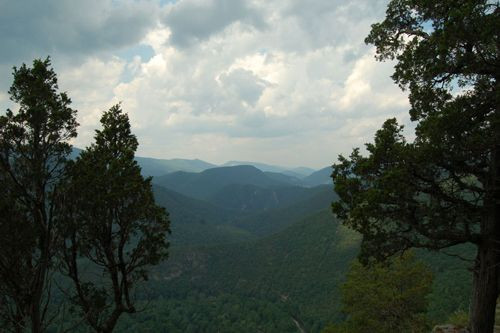Clean Air Act Is Working, According To Appalachia’s Red Cedar Trees

Elderly red cedar trees in the Appalachian Mountains are proof that congressional legislation can provide swift changes to benefit the environment. New evidence in the journal PNAS proclaims that the 1970 Clean Air Act helped forest systems recover in less than 10 years from nearly a century of choking pollution and acid rain.
"There is a clear shift in the [cedar tree] growth, reflecting the impact of key environmental legislation," said study author Dr. Jesse Nippert, a biologist at Kansas State University.
The U.S. Clean Air Act in its most notable form was passed in 1970, the same year that Congress established the Environmental Protection Agency. Its near unamious approval — 73 to 0 in the Senate and 374 to 1 in the House — marked the summit of a long pursuit by legislators to improve air quality, which had been polluted by industrial smog for most of the early 20th century and become considerable public health concern. Take the town of Donora, Pa., for example, where a cloud of killer smog from local steel mills covered the city in late 1948. Nearly half of Donora’s 14,000 residents became sick and 20 people died.
To see how far terrestrial environments have come since the 1970 Clean Air Act, Nippert and his colleagues looked at 100- to 500-year-old red cedar trees living in the forests of West Virginia in the Central Appalachian Mountains.
“The Central Appalachian Mountains have historically received some of the highest rates of acid deposition in the United States due to their downwind proximity to the abundance of coal-fired power plants in the Ohio River Valley,” wrote the authors, who were led by Dr. Richard Thomas, professor of biology at West Virginia University.
The team picked red cedar trees because they are long-lived and a good litmus test for environmental variability. In addition, debate has surrounded whether extra carbon dioxide, which promotes the growth of trees, can counteract the negative consequences of carbon pollutants, like acid rain.
The reseachers settled the score on the contentious issue by looking at tree rings — the layers of bark that pile up each year to make a tree’s trunk. They drilled and extracted narrow columns into the bark, known as increment boreing, which can provide hundred of years of a tree’s history and, when done correctly, doesn’t harm the plant.
The study found that extra carbon emissions in the air during the early 1900s did not increase the growth of the trees. Indeed, tree growth and physiology declined for the majority of the 20th century when acidic pollution — due to sulfur dioxide — was high. This pattern was revealed by cross-examining the chemical nature of each tree ring to catalogued measurements of atmospheric composition.
Ten years after the Clean Air Act's approval was the turning point for the cedar tree physiology.
"Our data clearly shows a break point in 1982, where the entire growth patterns of the trees in this forest started on a different trajectory," Nippert said. "It took 10 years for that landmark environmental legislation to reduce sulfur dioxide emissions, but it eventually did. When it did, we saw an entire ecosystem recover from years of acidic pollution."
Interestingly, a similar boost in tree growth was seen during the 1930s, which authors attributed to the Great Depression reducing coal production in the Ohio River Valley.
President Obama has turned to the 1970 Clean Air Act as a guide on how to tackle climate change in Congress. This current study could serve as model for measuring the impact of climate change laws in the future.
Source: Thomas RB, Spal SE, Smith KR, Nippert JB. Evidence of recovery of Juniperus virginiana trees from sulfur pollution after the Clean Air Act. PNAS. 2013.
Published by Medicaldaily.com



























